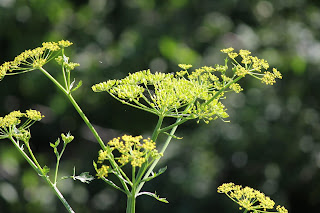Clinicians at the Freie Universität Berlin in Germany investigated a series of cases in which horses showed signs of inflammation of unpigmented skin.
Judith Winter and colleagues examined nine horses from stables in Berlin and Brandenburg, Germany, which showed variable degrees of erythema, scaling, crusting and necrosis of unpigmented skin on the head and prepuce. Most horses also showed signs of eye involvement: including conjunctivitis, photophobia and blepharitis (inflammation of the eyelids).
The clinicians found that, although the horses came from three separate yards, all stables were provided with hay from the same supplier.
Analysis of the hay showed that it contained large amounts of wild parsnip plants, including seeds and roots.
Wild parsnip (Pastinaca sativa) is widespread in Europe. It contains photodynamic pigments, known as furocoumarins. Contact with parts of the plant that contain the toxins, followed by exposure to sunlight, may cause photodermatitis, keratoconjunctivitis and uveitis. It is thought that lesions can occur due to both systemic uptake and direct topical contact.
Horses were treated with systemic anti-inflammatory medication as necessary, combined with topical treatment. They were protected from sunlight by being kept in a dark environment or by being treated with sunscreen and facemasks. Depending on the severity of the signs, treatment lasted from 6–30 days
Full details of the cases are published in BMC Veterinary Research.
For more details, see:
Photodermatitis and ocular changes in nine horses after ingestion of wild parsnip (pastinaca sativa)
JC Winter, K Thieme, JC Eule, E-M Saliu, O Kershaw, H Gehlen (2022).
BMC Vet Res 18, 80
https://doi.org/10.1186/s12917-022-03162-2


No comments:
Post a Comment